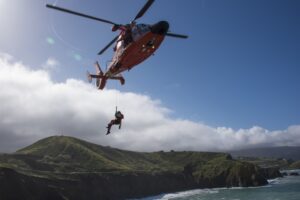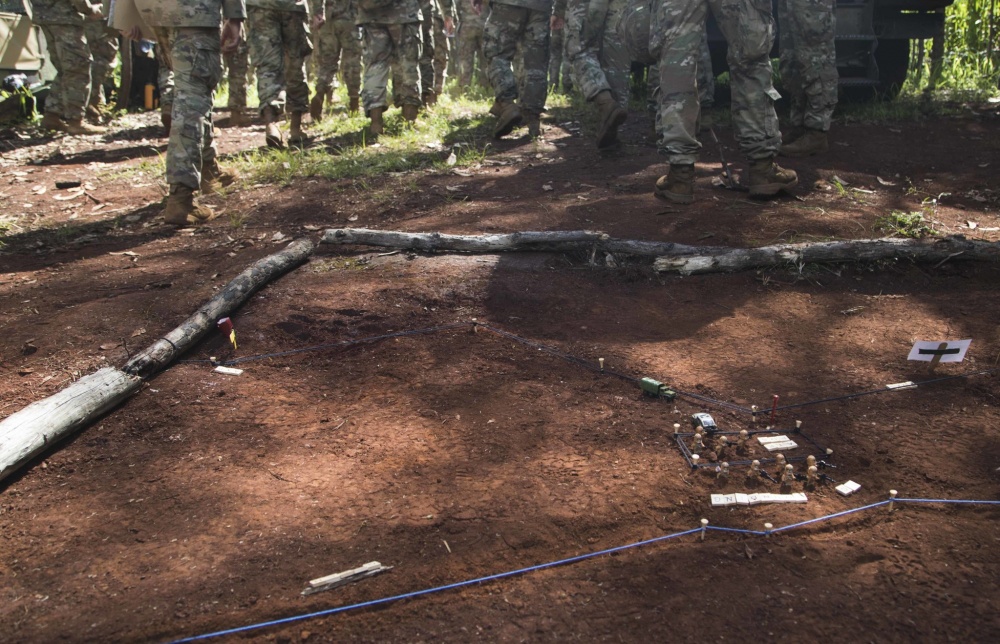
Aircrew members from Coast Guard Air Station San Francisco lower a rescue swimmer towards the cliffs of Mori Point in Pacifica, California, during vertical surface cliff rescue training, April 16, 2019. U.S. Coast Guard photo by Petty Officer 2nd Class Jordan Akiyama.
This post is part of a year-long series, The Paradox Problem. You can go here to see the introduction to the series, and see all the articles in the series here.
There is a statistic that I have always found fascinating. It demonstrates a number of things: the inherent danger of serving in the military, and how much better the military has become at reducing risk. According to a 2015 Congressional Research Service Report, the total number of U.S. active duty military deaths in 1980 was 2,392. The total number of active duty military deaths in 2010? 1,485. There was no war in 1980; in 2010, the US was at war in two different theaters of operation, and 2009-2010 was the height of the conflict in Afghanistan.
There are likely a number of things that contribute to this change in the fatality rate; improvements in medical care and better equipment are two that are most commonly cited. But one of the things that I think may be a significant factor is that the military has become much better at identifying and mitigating risks those thirty years. There were probably a lot fewer safety officers in 1980, and common safety measures now were much rarer then.
This is a core concept of the Risk-Taking Paradox:
Service members and veterans are experts at calculating and mitigating risks in the military, but engage in high-risk behaviors outside of the military environment
Unfortunately, while many of the paradoxes that veterans face after the military can be disruptive and uncomfortable, this paradox is extremely dangerous.
Veterans Calculated and Mitigated Risk in the Military…
As leaders in the military, risk mitigation and safety were a significant part of what we did. During weapons training, vehicle movement, physical fitness, and thousands of large and small ways, everything was done to reduce the risk of serious injury or death. In the military, we recognized that the greatest strength of any particular unit was the individuals in the unit themselves. Even when safety was uncomfortable or cumbersome, it had to be considered. As a Platoon Sergeant, I couldn’t even take my troops on a eight mile ruck march without turning in a risk assessment signed by my Platoon Leader. Risk identification and risk mitigation was part of the planning process, and it was designed to keep people safe.
Risk identification and mitigation was especially true in combat. The Army’s five paragraph operations order format identified the enemy’s most likely course of action (what they would most probably do) and the enemy’s most dangerous course of action (what is the most dangerous thing they could do). These two levels of risk identified, the unit preparing for the mission would do what they could to mitigate that risk. That’s why units had all the ammo that they could carry…to be able to be prepared in the event that the most likely or most dangerous course of action would come about.
…but Engage in High-Risk Behavior Out of the Military
Once a service member leaves the structured and safety-oriented military environment, however, the high-risk behavior escalates. The military leaves a large space in the service member’s life, and that space is going to be filled by something; often, that space is filled by high-risk behavior. Drinking and driving, experimenting with substance use, unprotected sex, high-speed driving in cars or on motorcycles; many veterans indicate that this is an attempt to “chase the high” that they experienced in the military. This is especially true for those who were exposed to significant combat; this study in 2008 showed that Iraq War veterans who experienced high levels of combat were more likely to engage in risk-taking behavior upon returning home.
The problem is that those things that provided that adrenaline rush in the military…firing weapons, jumping out of airplanes, tricky vehicle maneuvers…were all structured in such a way as to minimize the risk as much as possible. Outside of combat, jumping out of airplanes was the most risky thing I did in my 22 year military career; a high-risk and complex operation, it took days of planning and hours of preparation before stepping out of the door of an airplane with a parachute strapped to your back. When in the military, the dangerous things were prepared for and rendered as safe as possible; when out of the military, the dangerous things are simply dangerous.
Resolution
Resolving the risk-taking paradox is one of the most important things that a veteran can do for satisfaction in post-military life. Some of the resolution may take the form of engaging in adrenaline-producing activities in a safe and responsible manner…taking up a thrilling hobby, such as surfing or rock climbing. Without the structure of the military leader to ensure safety, veterans must recognize the need for safety themselves and implement it in their own lives. The goal is the same…preservation of the self in order to contribute in the maximum manner possible.
Another way to resolve the risk-taking paradox is to change our mindset. We can come to terms with the fact that, regardless of whether we want it to be or not, the dangerous lifestyle of military service is behind us. Our war is over, even if the war we were fighting is isn’t; that’s the nature of the military, that the individuals come and go but the fighting force endures.
Both of these methods of resolving the risk-taking paradox requires awareness. Awareness that the behavior we are engaging in is not beneficial, even if it feels good. Awareness that we are probably doing more harm to ourselves and others around us that we may want to do, if we were in a different frame of mind. With awareness comes action, and action, driven by awareness, is the only real way to make changes in our lives.
This post is part of a year-long series, The Paradox Problem. You can go here to see the introduction to the series, and see all the articles in the series here. This paradox, and many others, were identified in a 2015 article in the Journal of Traumatology, authored by Carl Castro, Sara Kintzle, and Anthony Hassan.
Castro, C. A., Kintzle, S., & Hassan, A. M. (2015). The combat veteran paradox: Paradoxes and dilemmas encountered with reintegrating combat veterans and the agencies that support them. Traumatology, 21(4), 299.
Do you want to help offset some of the costs of the Head Space and Timing Blog and Podcast? Want to show your appreciation and support? You can put some paper in the tip jar by going here or clicking the button below



1 Comment
Paul Sawayer · February 24, 2021 at 12:19 pm
I love that article. I think another element perhaps that plat a role is how team and group oriented the military is. The “me and I”, takes a backseat to the “we and us”.
Are the support groups provided to Veterans by the VA a good “bridge” to fill the gap that some Vets are seeking as civilians? As a peace officer I saw many Vets involved in high risk behaviors. Stellar individuals in the military who found their way to drugs and homelessness. I knew they had the training and discipline as soldiers. The social motivation of the troop was missing.
Comments are closed.